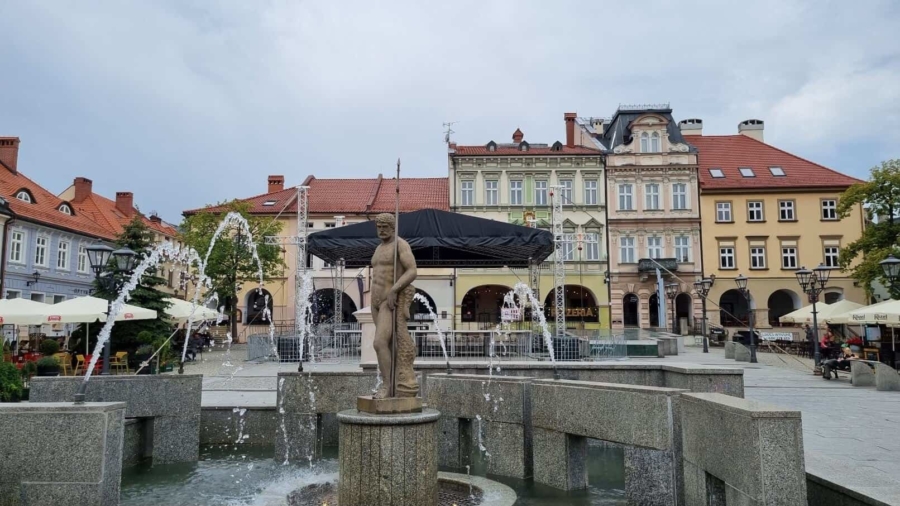My wife and I had a long day on the road on a very warm Sunday, July 9, 2023. We left Bosnia at 5am and arrived in Bielsko-Biała in Silesia a little after 4pm. Truly shattered, I wasn’t in the position to give much thought to the following day’s self-guided walking tour of Bielsko-Biała we planned to embark on.
We checked into our apartment. The contactless, self check-in kind. All I can say is that the world’s gone very mad indeed.
Anyway, a thought occurred to me while I was in the shower that evening. I’ve never paid heed to what the Silesian Voivodeship has to offer tourists. I’ve never paid heed to that age-old stereotype which permeates Polish society – Silesia is nothing but a polluted dump that’s full of mines and run-down, rat-infested tenement houses. There’s beauty in Silesia. Lots of it.
Back to the apartment. Bielsko-Biała is surrounded by greenery, as we had the pleasure of viewing from the balcony of our apartment:
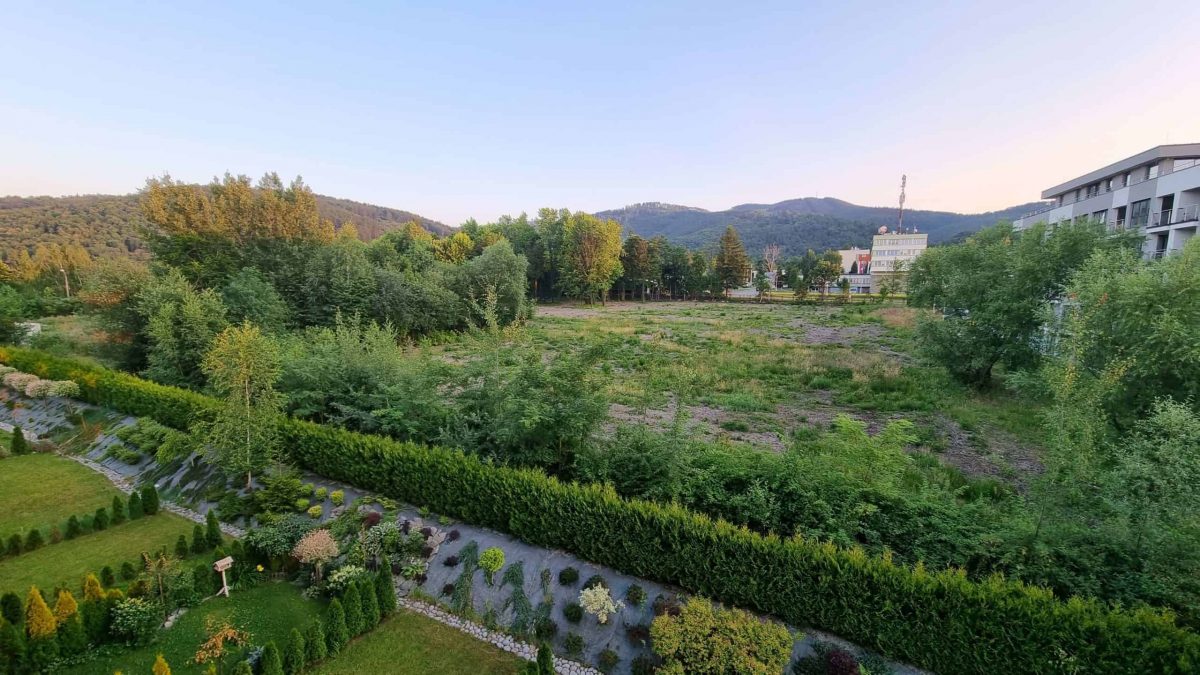
With the sunset painting some wonderful colours in the sky above Bielsko-Biała, I reflected on what had been a long day.
Unsurprisingly, I slept like a log.
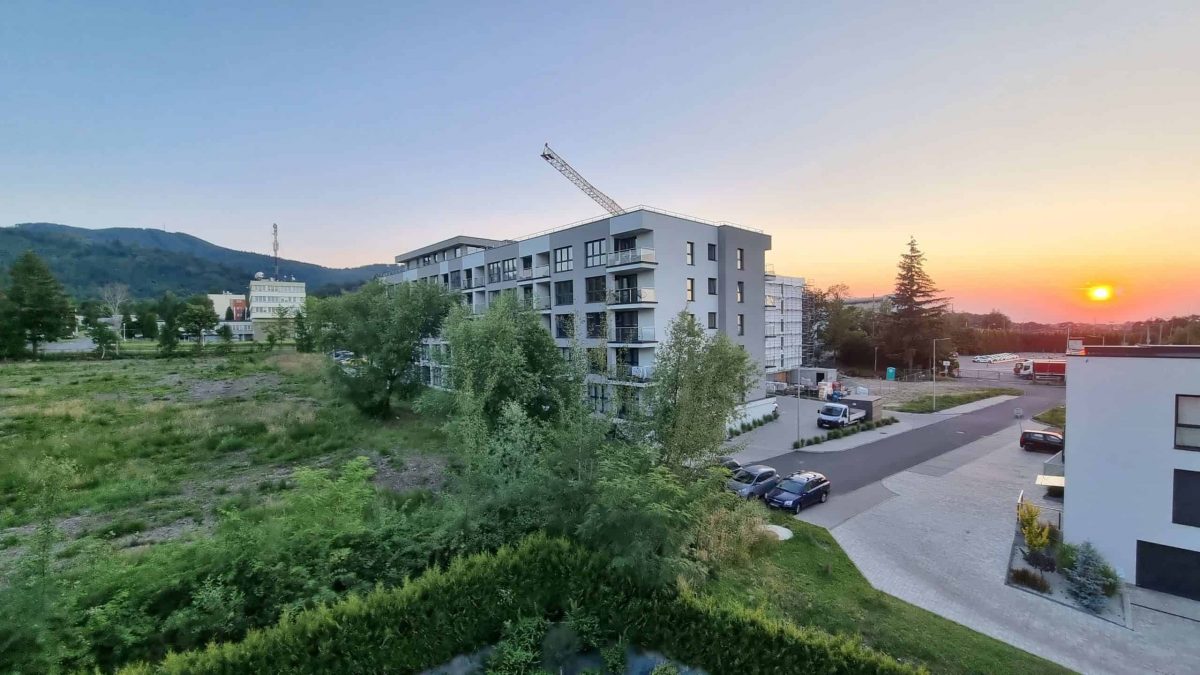
A little bit about Bielsko-Biała
Bielsko-Biała, picturesquely situated just north of the Beskid mountains, is one of the most fascinating castle towns in southern Poland.
The city has only been known by its current name since January 1, 1951, when the two former towns of Bielsko (in the west) and Biała (in the east) officially merged. Prior to that date, the towns were located on opposite banks of the Biała River.
Bielsko was originally in the province of Cieszyn Silesia. Archaeological research has revealed that the old town hill was inhabited as early as the beginning of the 13th century. Bielsko was first documented in 1312 when Mieszko I, Duke of Cieszyn, granted a town charter. From 1327, Bielsko belonged to the Kingdom of Bohemia. Both Cieszyn Silesia and Bohemia were incorporated into the lands of the Habsburg Monarchy in 1526.
Biała, then in the region of Lesser Poland, was established in the 16th century. Granted civic rights in 1723, Biała was sited on Poland’s western border. In 1772, the town was ceded to Austria after the first partition of Poland, and subsequently integrated into the newly created province of Galicia.
Since the 19th century, both Bielsko and Biała essentially functioned as one urban area, known as Bielsko-Biała.
Both cities became part of the reconstituted Polish State in 1918.
The Biała River
As I’ve already alluded to, the Biała River is remarkably historic. After all, the river used to divide the Kingdom of Bohemia from the Kingdom of Poland (1457-1526), the Habsburg Empire from Poland (1526-1772), Austrian Silesia from Galicia (1772-1918) and the regions of Silesia and Kraków (1922-1950). As previously stated, the Biała River also divided Bielsko from Biała until January 1, 1951.
A self-guided walking tour of Bielsko-Biała
We got up a little after 8. A very warm and humid day had been forecast.
Our apartment, on Armii Krajowej Street, is situated around 5 kilometres or so from the Old Town Square. There wasn’t much chance we were going to cover that distance on foot in such muggy conditions. Therefore, we drove down the hill and parked up in the underground garage of Gemini Park shopping centre. From there, it’s only a 2.5 km walk to the major sights in the Old Town.
Of course, we could have parked much closer to the Old Market Square. However, Gemini Park is but a short walk from Park Włókniarzy – where we began our walking tour of Bielsko-Biała.
1. Park Włókniarzy
Park Włókniarzy, literally “Textile Workers’ Park”, is in a part of former Bielsko that used to be called “Bleach Alley”. This is due to the fact that linen was bleached here in the past.
Beginning in 1895, the city gardener Franz Chlupacz began to shape the park step-by-step by landscaping meadows and wasteland nearby the riverbank.
Situated between a main road and the Biała River, Park Włókniarzy is a long, narrow park which provides ample opportunities for relaxation.
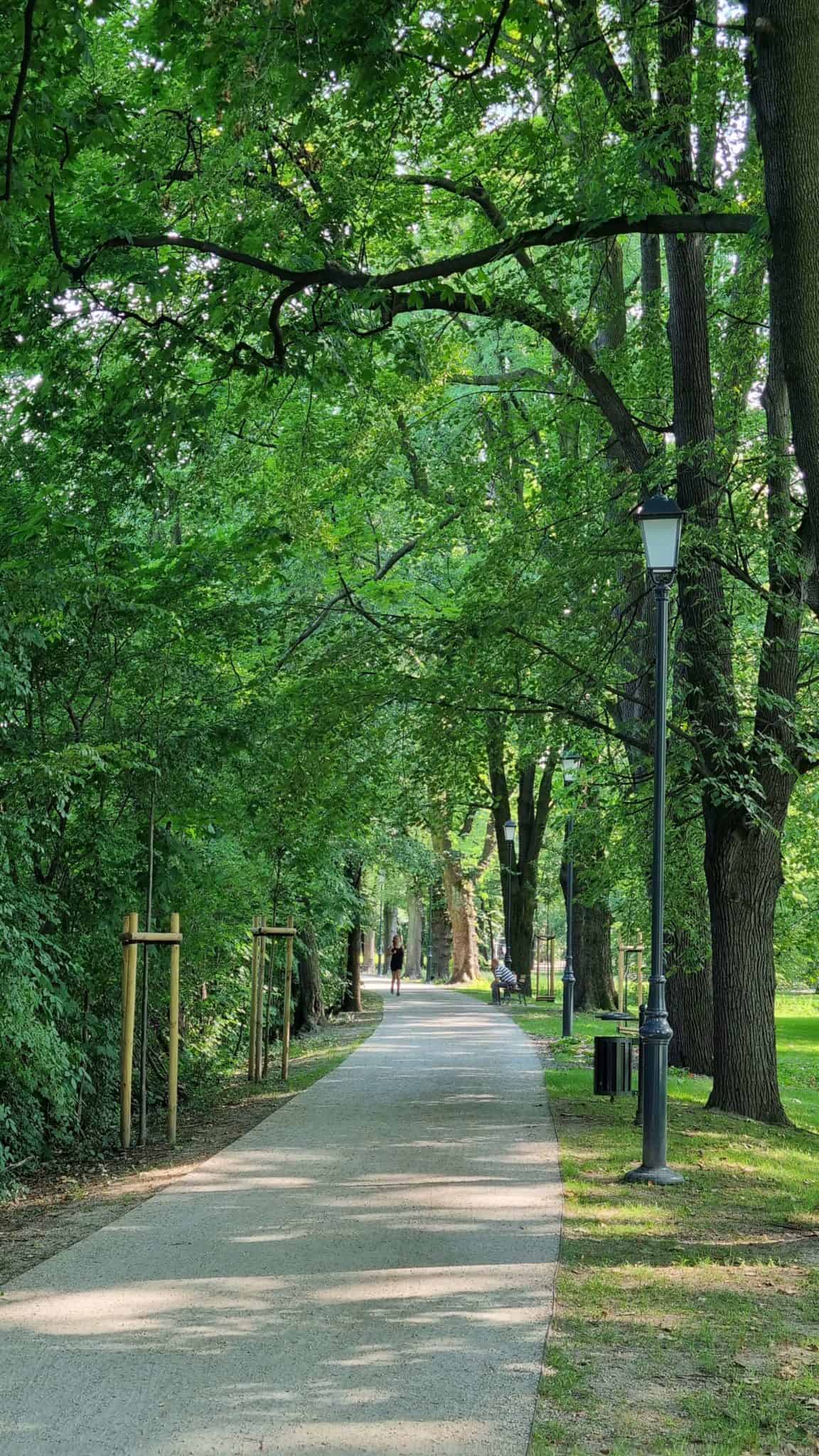
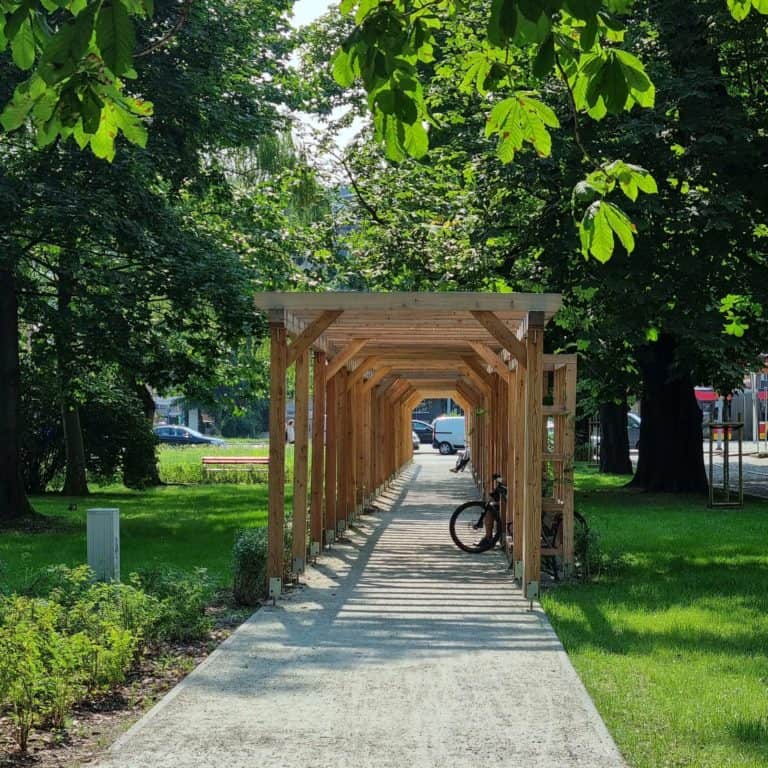

2. Cavatina Hall
After exiting Park Włókniarzy, we marched in a northerly direction towards the Town Hall. On the way, we admired Cavatina Hall for its contemporary steel and glass architecture.
Primarily functioning as a concert hall, Cavatina Hall has been designed in such a way that all kinds of music sound perfectly throughout its interior. Its acoustics bring out the full colour of sound during symphonic concerts, chamber concerts of classical music, and pop concerts.
The building also offers an abundance of A-class office space.
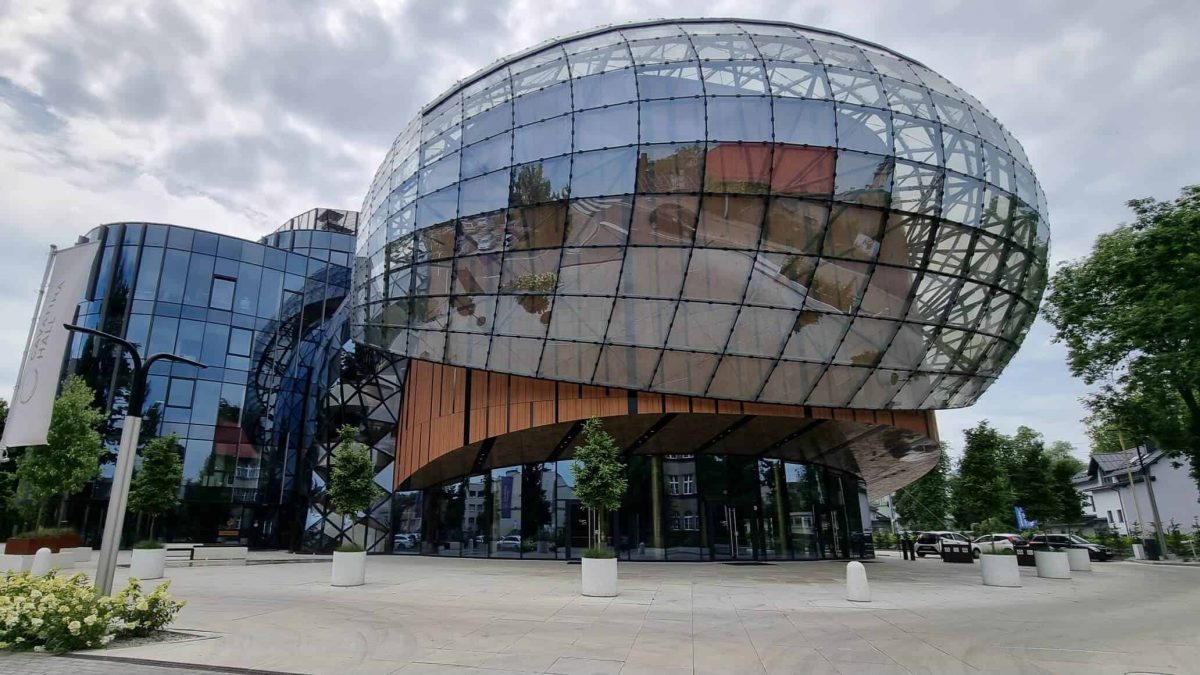
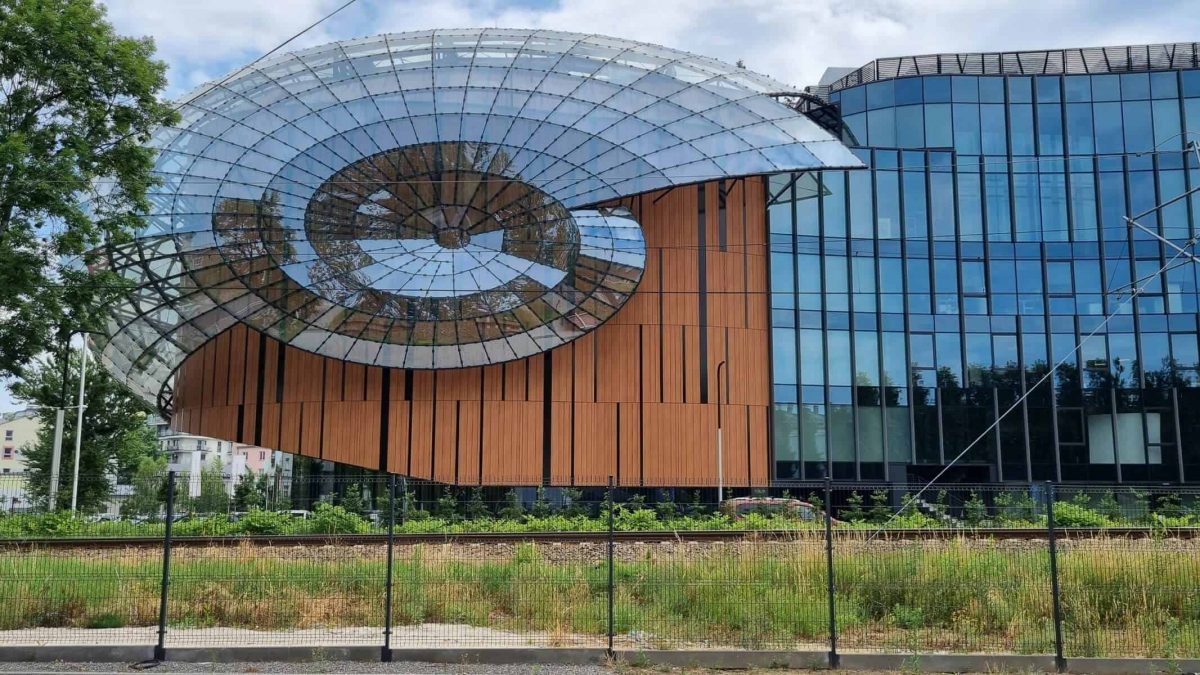
3. ‘Bielsko-Biała Storytime’ Trail
Before we reached the Town Hall, we stumbled across the sculpture of the animation cartoon character Pampalini the Animal Hunter.
It’s an appropriate time to explain more about Bielsko-Biała’s connections with Polish animation.
The Animated Film Studio (Studio Filmów Rysunkowych) is based in Bielsko-Biała, currently located at Cieszyńska 24 Street.
Established in 1947, the Animated Film Studio has produced over 1,000 films for children and adults. Hence, the most celebrated heroes of Polish were born in Bielsko-Biała. These characters include Bolek and Lolek, Tola, Reksio the dog, Hip-Hop the kangaroo, Bartłomiej Bartolini the cook, the Wawel Dragon and many others.
In the city centre, the ‘Bielsko-Biala Storytime’ trail (szlak ‘Bajkowe Bielsko-Biała’) presents the heroes of bedtime tales created by the Animated Film Studio in sculpture form.
Check out which animation characters you can see when following the ‘Bielsko-Biała Storytime’ trail:
Pampalini the animal Hunter and a Hippopotamus (Pomnik Pampaliniego)
Pampalini the animal hunter was a kind but clumsy character. The sculpture of Pampalini and a hippo was unveiled in 2019 on the banks of the Biała River right by the ‘Crooked Bridge’. This is close to the Town Hall.
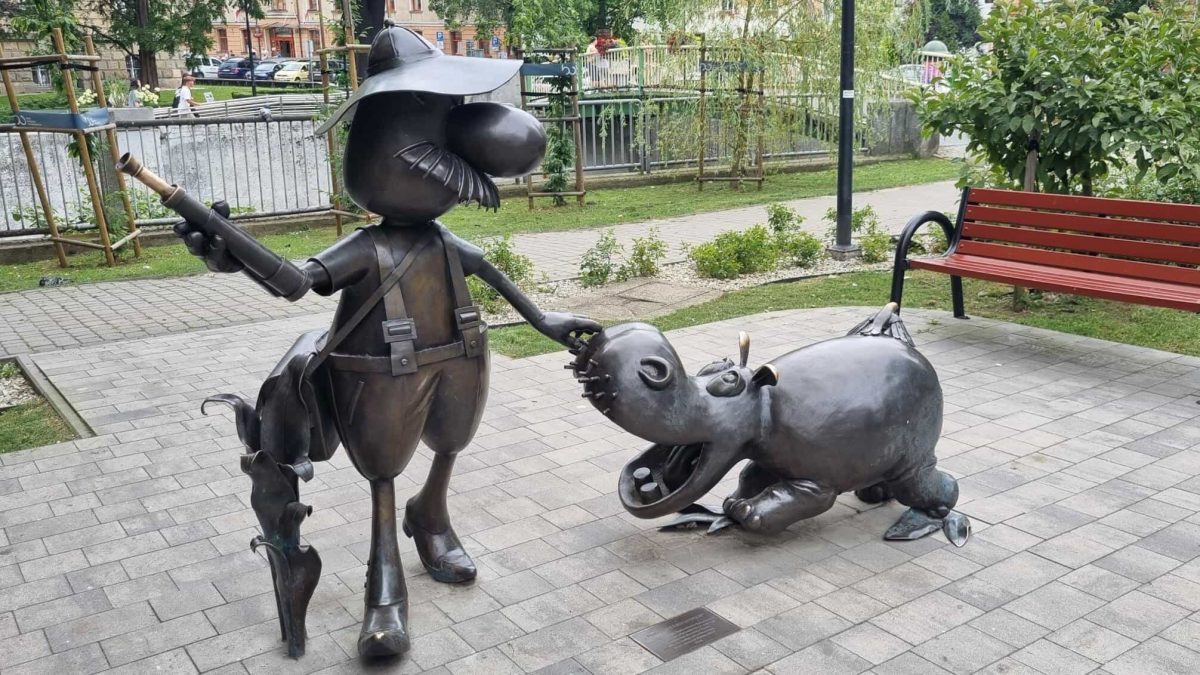
The Wawel Dragon and the cook Bartłomiej Bartolini (Pomnik Baltazara Gąbki)
The Wawel Dragon and the cook Bartłomiej Bartolini are characters from the popular series The Abduction of Baltazar Gąbka. Along with the car in which they travelled, you can see their sculpture on 11 Listopada Street.
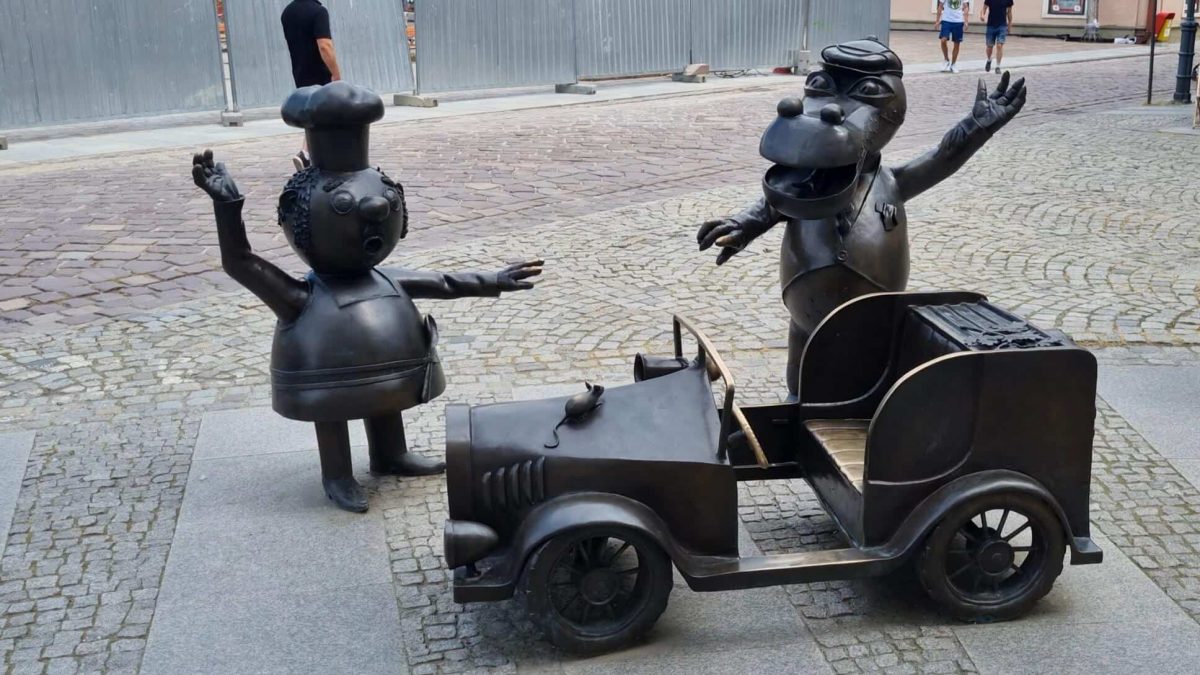
Don Pedro de Pommidore the Spy from the Land of Rain People and Myping (Pomnik Don Pedra z krainy Deszczowców i Myping)
Right next to the Wawel Dragon and Bartłomiej Bartolini, you will spot a sculpture of Don Pedro de Pommidore the Spy from the Land of Rain People. His role in the animated series was to torment Baltazar Gąbka and his friends. Next to the Spy stands Myping, a creature that haunted the Principality of Krak in the tales.
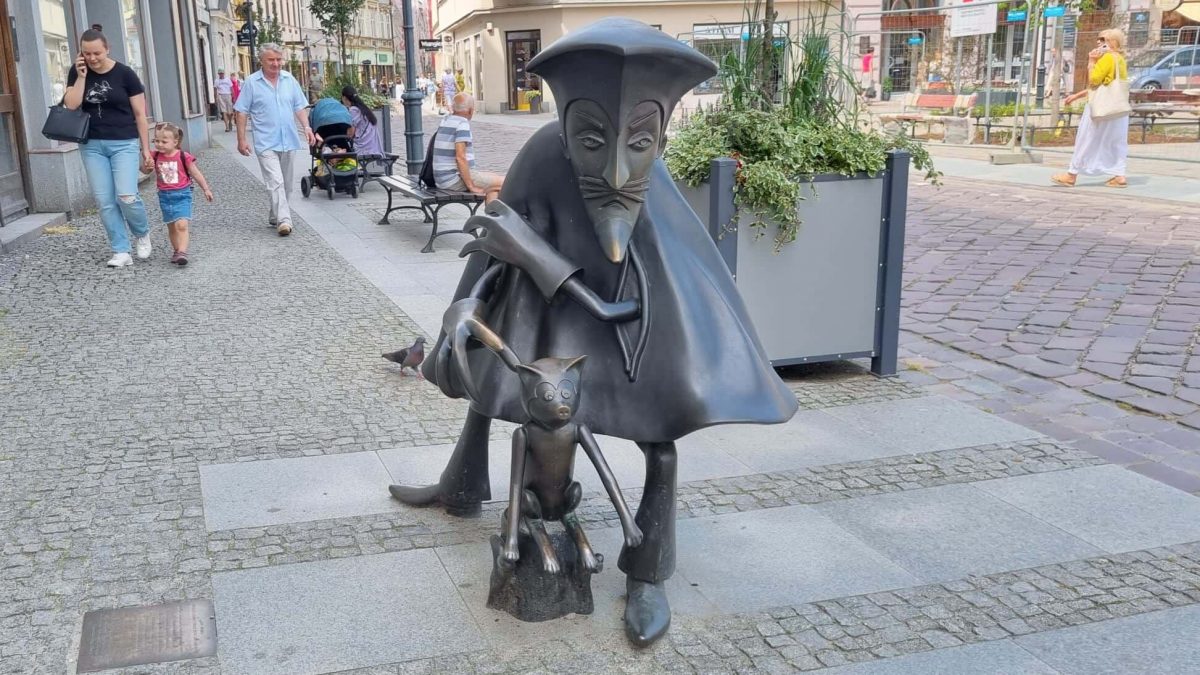
Reksio
The cute little dog – Reksio – still wins the hearts of his avid viewers. Sixty-five episodes of Reksio’s adventures were created over a twenty-three year period. His sculpture can be found on the square by the fountain between 11 Listopada Street and Stojałowskiego Street.
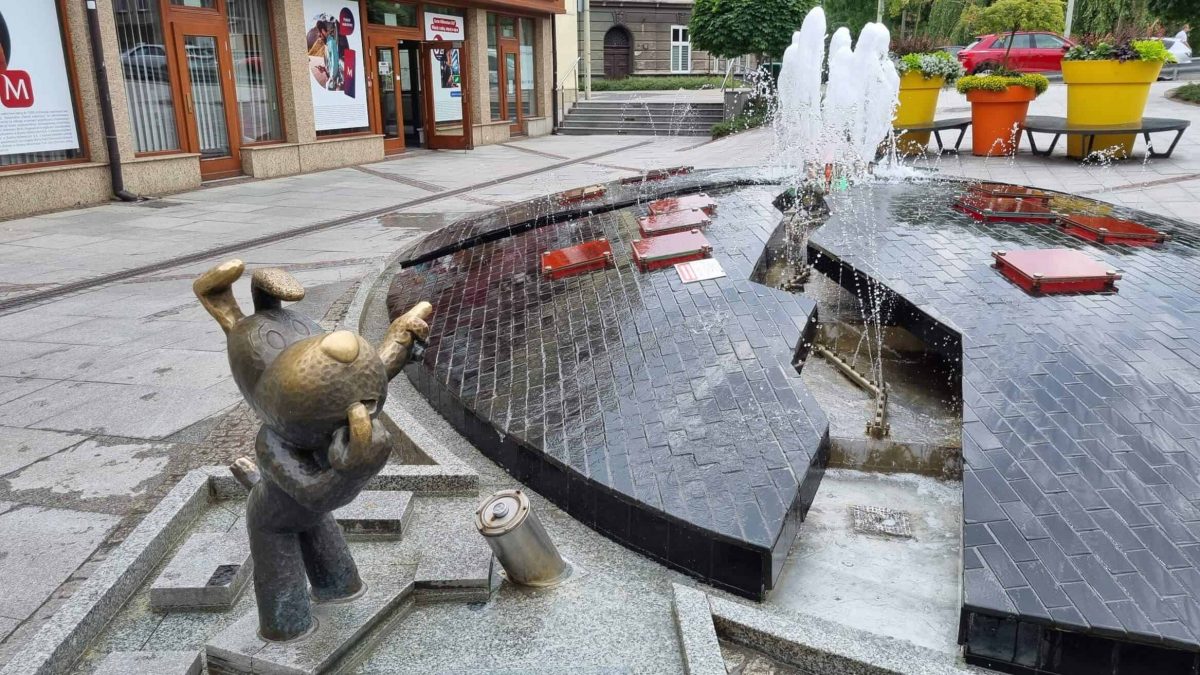
Bolek and Lolek
The cartoon idols – Bolek and Lolek – are world-renowned. The adventures of these two brothers were shown in over 180 short films as well as two feature films.
Check out the sculpture of Bolek and Lolek on Mostowa Street, between the two main sections of Sfera shopping centre.
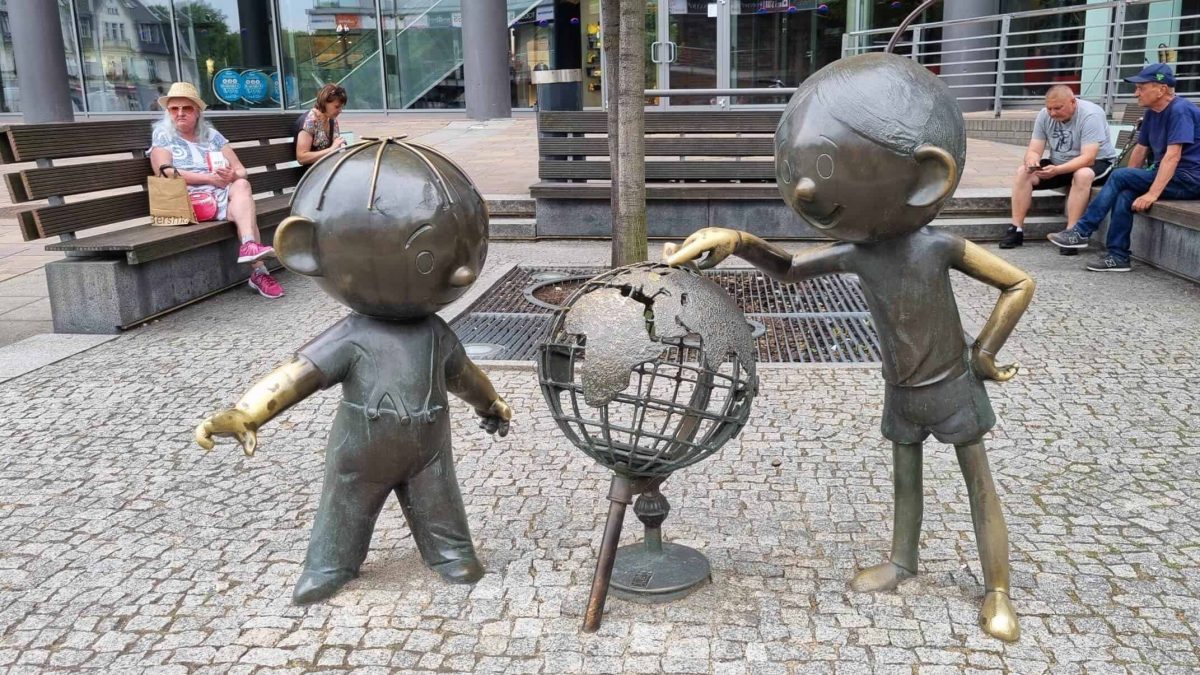
4. The Town Hall and Town Hall Park
After checking out the sculpture of Pampalini, we crossed what is known as the ‘Crooked Bridge’, close to Bielsko-Biała Town Hall (Ratusz):
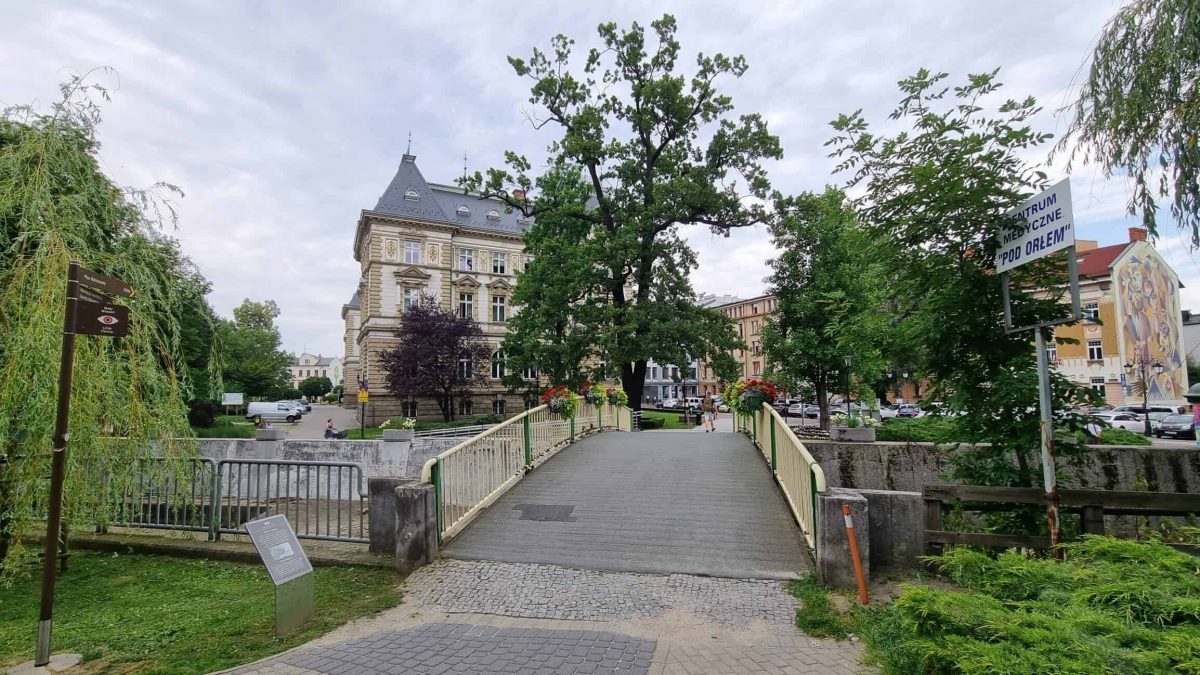
We then made our way to the park behind the Town Hall. The park was established at the end of the 19th century based on English garden design principles. All in all, the park is a wonderfully secluded spot in the city centre.
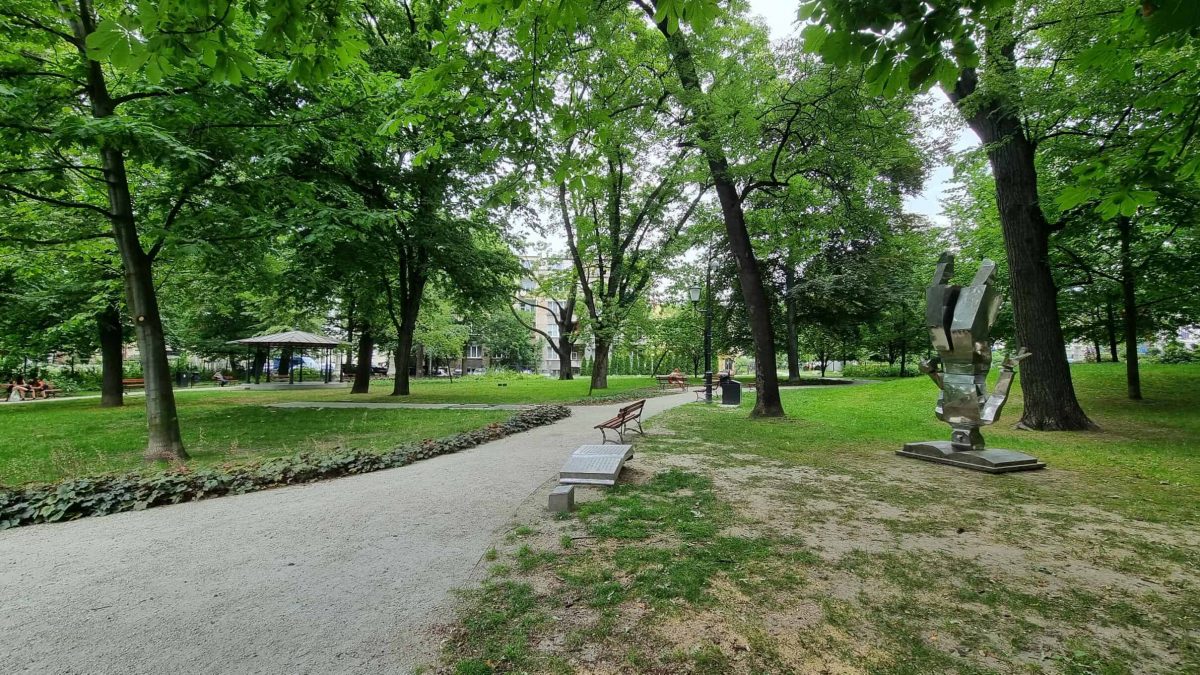
A Sculpture of an Acrobat (Rzeźba Akrobata) immediately catches the eye. The sculpture, by Dariusz Fodczuk, was unveiled in 2009. “Acrobat” is a four-metre-high steel sculpture of a man standing on his head on an open book. The artist’s intention was to refer to important events in Bielsko-Biała in the second half of the 19th century, when both neighbouring cities were modernised thanks to the efforts of their citizens. In an open book made of steel lying near the “Acrobat”, you can read:
„W drugiej połowie XIX wieku, wysiłkiem obywateli, w Bielsku-Białej wprowadzono pionierskie rozwiązania techniczne. Zostały uruchomione: gazownia, elektrownia i wodociąg miejski, jedna z pierwszych w świecie sieć telefoniczna, druga na terenach polskich elektryczna linia tramwajowa. Ulice oświetlono lampami, ze składek mieszkańców wybudowano teatr. Marzenia łączyły ze sobą ludzi różnych wyznań i narodowości. W hołdzie tym, którzy odważyli się uwierzyć w człowieka.”
Roughly translated:
“In the second half of the 19th century, thanks to the efforts of citizens, pioneering technical solutions were introduced in Bielsko-Biała. The following were launched: a gasworks, a power plant and a municipal water supply, one of the first telephone networks in the world, and the second electric tram line in Poland. The streets were illuminated with lamps, and a theatre was built through the contribution of citizens. Dreams brought together people of different faiths and nationalities. In tribute to those who dared to believe in mankind.”
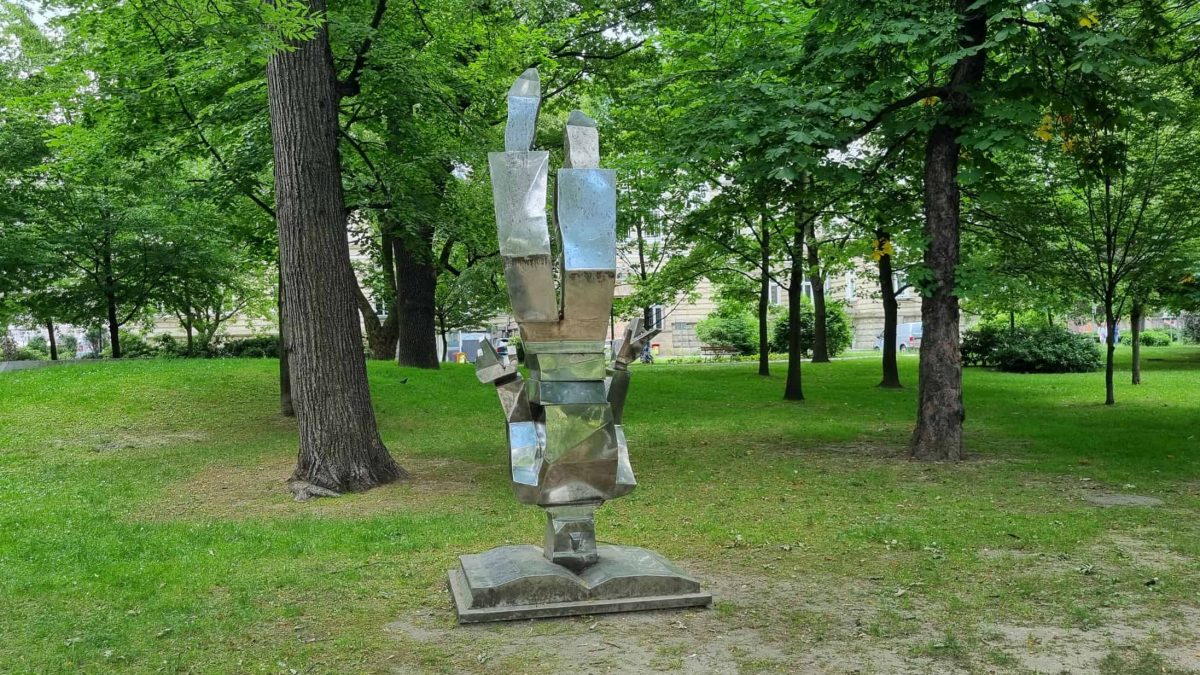
Air-raid shelter
Within the park’s borders you can also find two separate entrances to an air-raid shelter, and a tunnel connecting the Town Hall with the park:

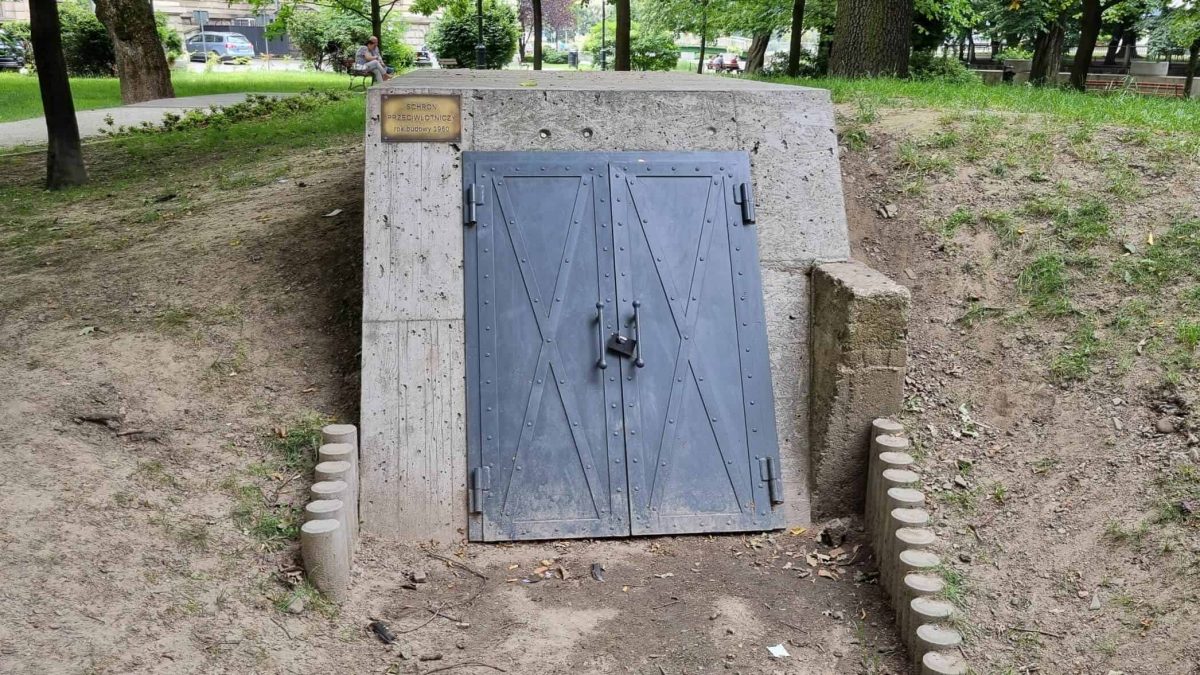
A Neo-Renaissance building to admire
Moving on to the Town Hall itself. This Neo-Renaissance building was originally a Communal Savings Bank and the Town Hall of Biała. These days, it is the seat of the Municipal Council of Bielsko-Biała.
Constructed to the design of Bielsko architect Emanuel Rost junior, it first opened for business in 1897.
The building underwent a comprehensive renovation in 1997.
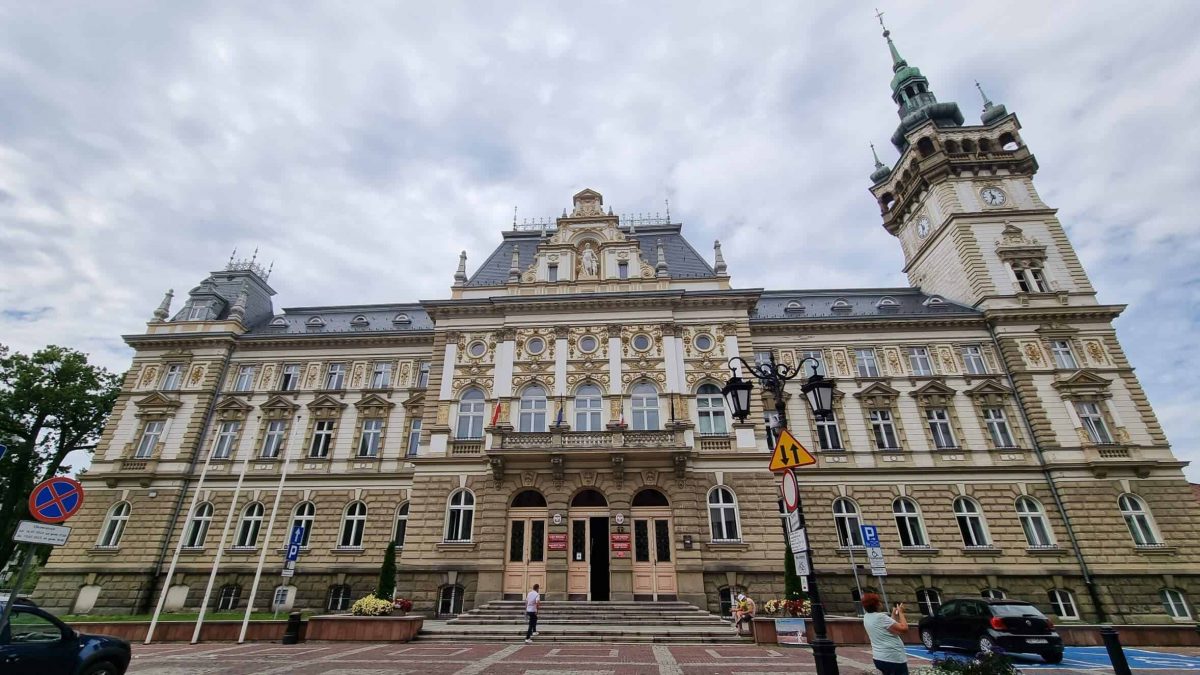
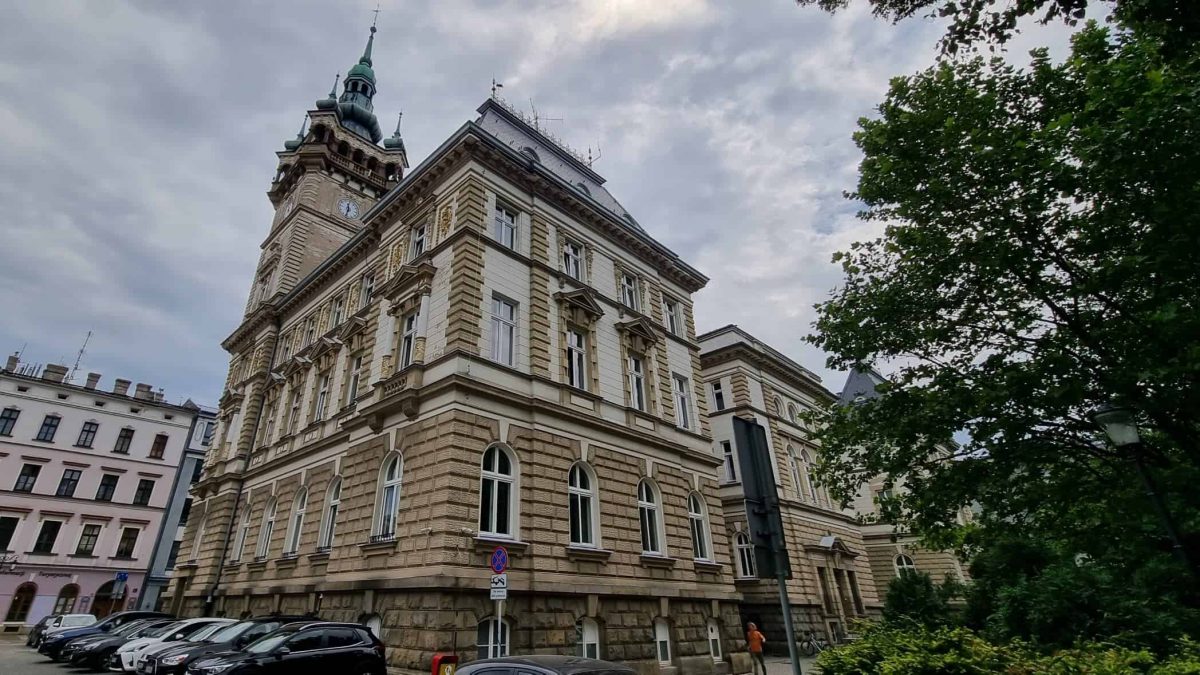
5. Stroll down 11 Listopada Street
After admiring the Town Hall, we walked north along Ratuszowa Street. Being a very short street, we soon emerged onto 11 Listopada Street – the main pedestrian street of Bielsko-Biała. It’s around 900 metres long. This street should be a mainstay of every self-guided walking tour of Bielsko-Biała due to the weight of history that’s behind it.
Until 1890, this street was known as Vienna Street, and later Main Street. Between 1777 and 1785, it formed part of the Imperial Highway connecting Biała to Lviv. The Biała-Bochnia section was opened in 1781.
We admired the architecture of Strzygowski’s Palace (Pałacyk Strzygowskiego). This palace was built after 1878 for the textile manufacturer Franciszek Strzygowski (1828-1904) on the site of a 1766 house which had previously belonged to the mayor of Biała, Karl Męcnarowski. After 1910, the palace was the property of Strzygowski’s daughter, Elvira. She was the wife of the paper manufacturer Alfred Fiałkowski.
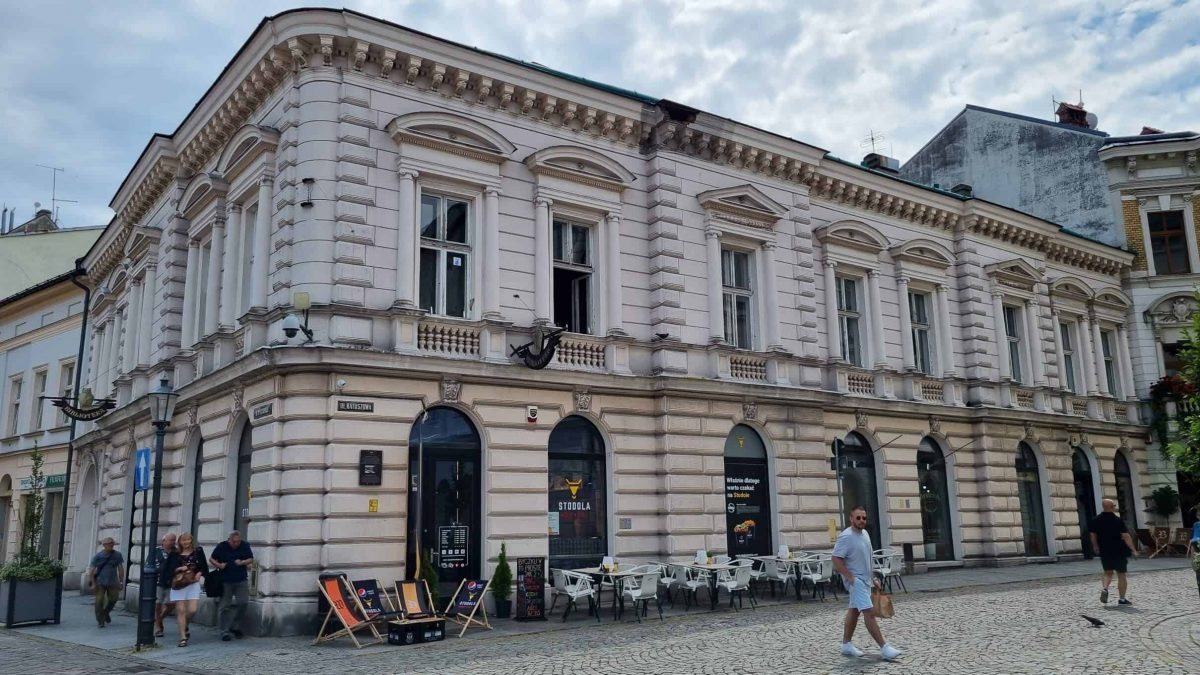
Onwards we strolled, taking in the townhouses and tenement houses along the way. The buildings which line the street are exquisite examples from the period of Emperor Joseph II.
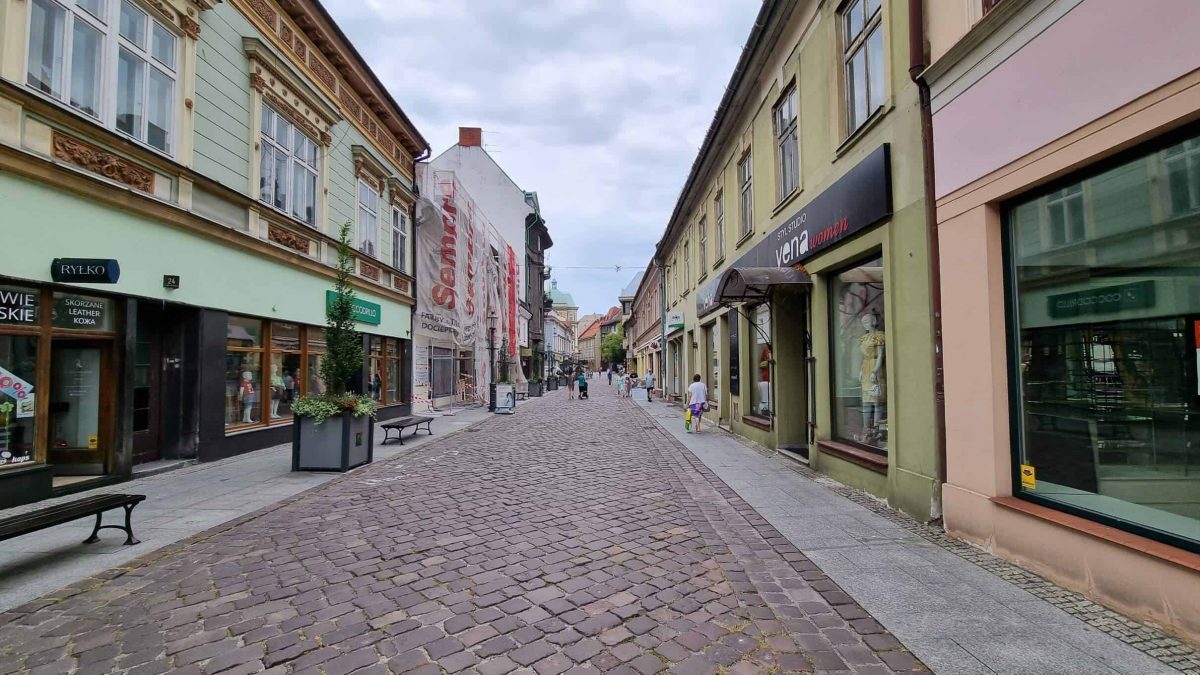
A Vegan Lunch
Towards the eastern end of 11 Listopada Street, we stopped off for lunch at the vegan restaurant Jarmużno. Although I’m not a vegan, I’m happy to go vegan for lunch from time to time as the dishes I have tried were all delicious.
Anyway, I had the vegan lasagne (Lazania Veganese) which consists of tomato sauce, mushrooms, spinach, garlic, and wheat pasta. It comes with salad and cheese sauce. The wife went for the Wrap Jarmużno – homemade tortilla baked on site with millet chops. All in all, the portions were generous, the food was tasty and the service was friendly.
We left Jarmużno and walked back down to the end of 11 Listopada Street. Here, we turned left onto Barlickiego Street and soon reached Wzgórze. It was here that the Castle of the Sułkowski Princes came into view. The next phase of our walking tour of Bielsko-Biała was upon us.
6. Chrobry Square (Plac Bolesława Chrobrego)
Adjacent to Ulica 3 Maja just below the castle, there’s a stunning square called Plac Bolesława Chrobrego.
Built in the mid-nineteenth century, the square and the wider Dolne Przedmieście district quickly gained prominence at the expense of the Old Town. Indeed, the district became the focal point of the city’s urban development. Tenement houses (baroque, neo-style and modernist), factory owners’ villas and public utility buildings were built here.
The current name goes back to 1925. Prior to that time, the square was called ‘Pottery Place’ to reflect the new trade in ceramics.
The central point of the square is the Fountain of ‘Three Children’ (Fontannie ‘Troje Dzieci’).
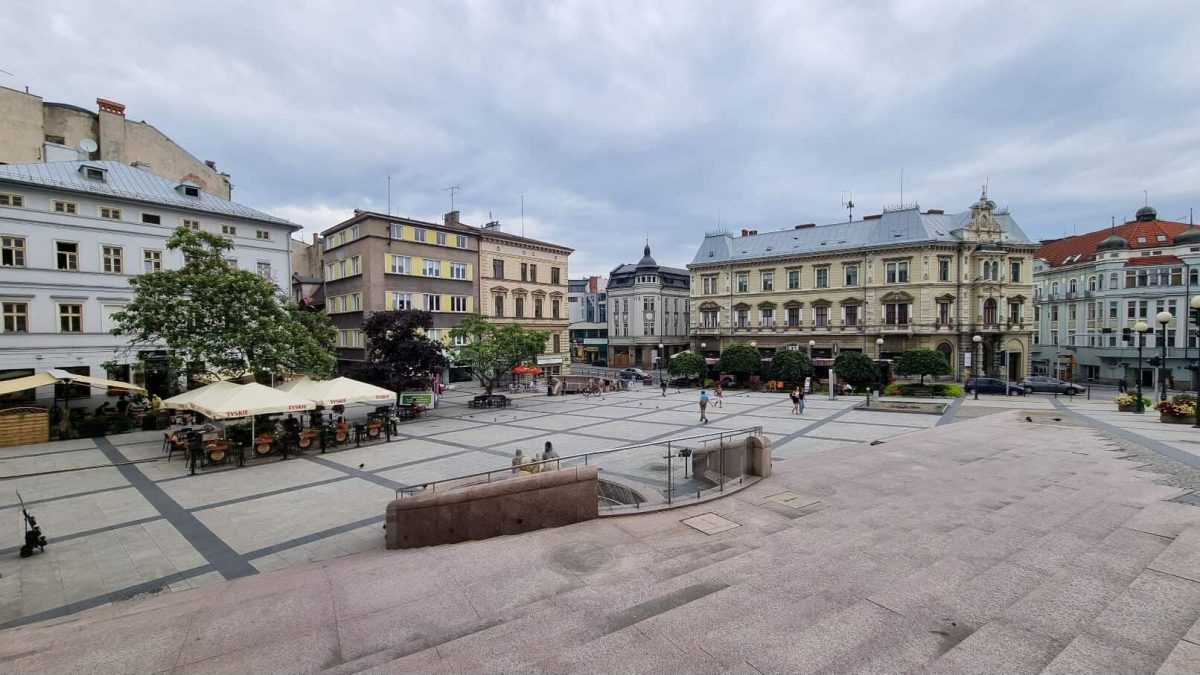

One building worth checking out is the so-called Kałuża’s House. A late-baroque style tenement, it was built by Johann Bartelmuss, a merchant, in the second half of the 18th century. Between 1879 and 1917, it was owned by Karol Kałuża, a bookbinder.

All in all, Chrobry Square makes for a wonderful prelude to a visit to the Castle followed by the Main Square.
7. The Castle of the Sułkowski Princes and the Museum of Bielsko-Biała
The Castle of the Sułkowski Princes houses the Museum of Bielsko-Biała. It’s the oldest and largest historical building in town.
The Castle was once a residence of the Cieszyn Piast dynasty and then nobility, which included the Sunnegh and Sułkowski families.
After 1572, it became the administrative and economic centre of what was known as the State of Bielsko.
The oldest preserved remains of the castle date back to the second half of the 14th- century. Over the ages, the castle was repeatedly extended. Its present appearance was fashioned in the late 1850s and early 1860s.

Walking to the southern end of the castle from Chrobry Square, we came across the Castle Chapel of St.Anne (Kaplica zamkowa św. Anny). The chapel was added to the main body of the castle in the years 1853-1855. Prince Ludwik Sułkowski commissioned the chapel to commemorate his wife Anna, who died in 1853. In fact, the chapel was built on the site of an earlier chapel which was destroyed by fire in 1836. The Castle Chapel became the site of interment for all subsequent rulers of the castle.
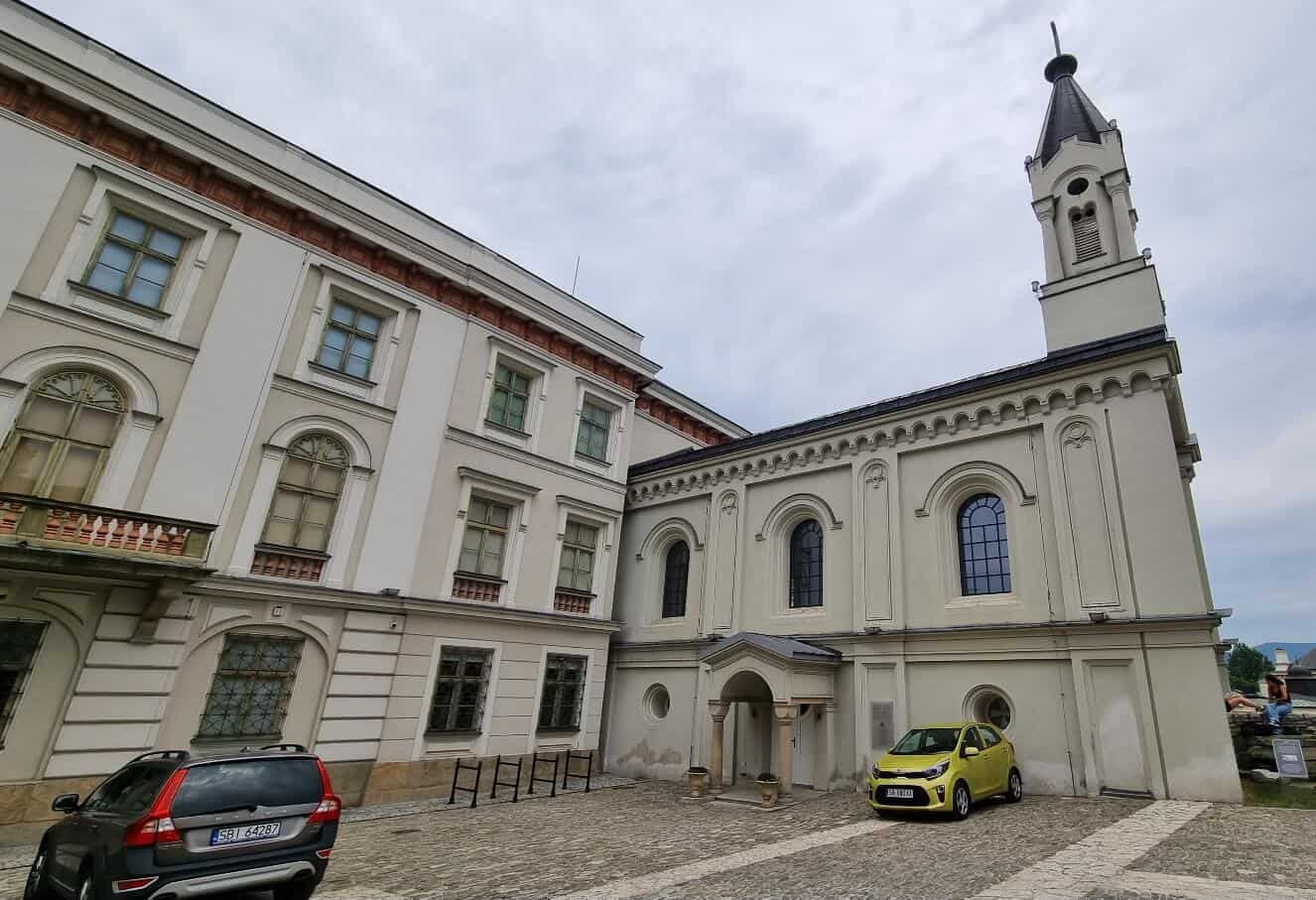
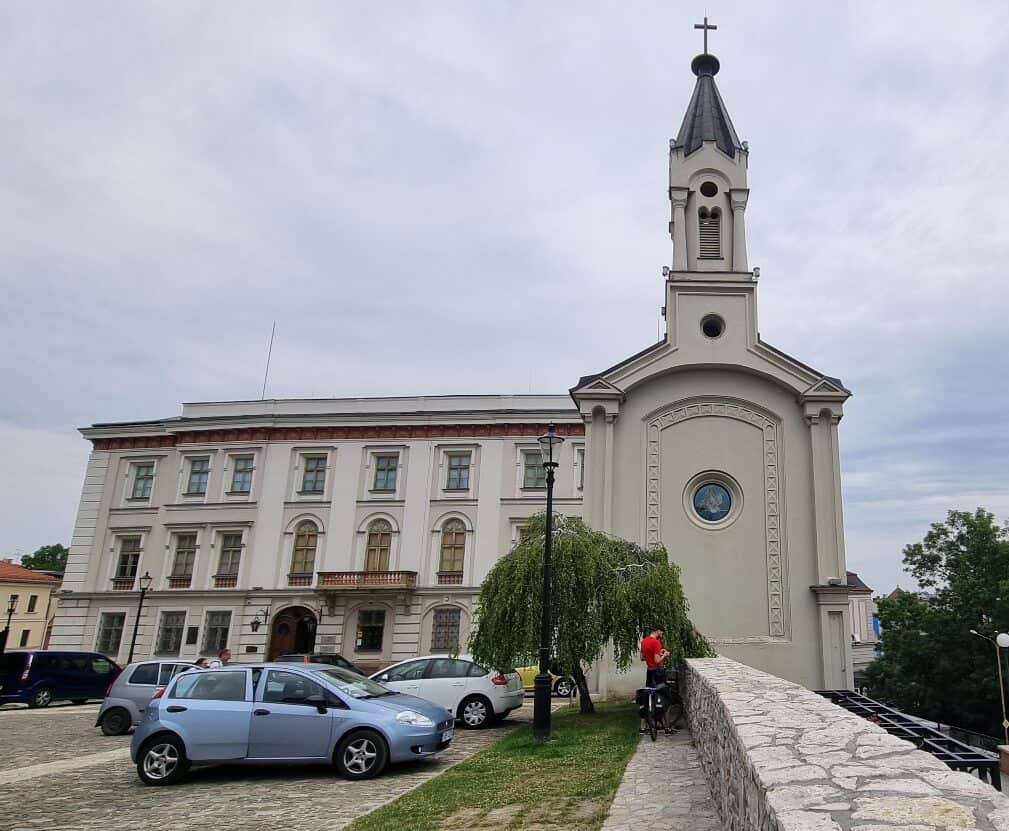
8. Old Town Market Square
Our walking tour of Bielsko-Biała was drawing to a close. However, my overriding feeling was that we were saving the best for last in the form of the Old Town Market Square (Rynek).
From the Castle Chapel of St.Anne, we walked up the appropriately named Ulica Wzgórze (Hill Street).
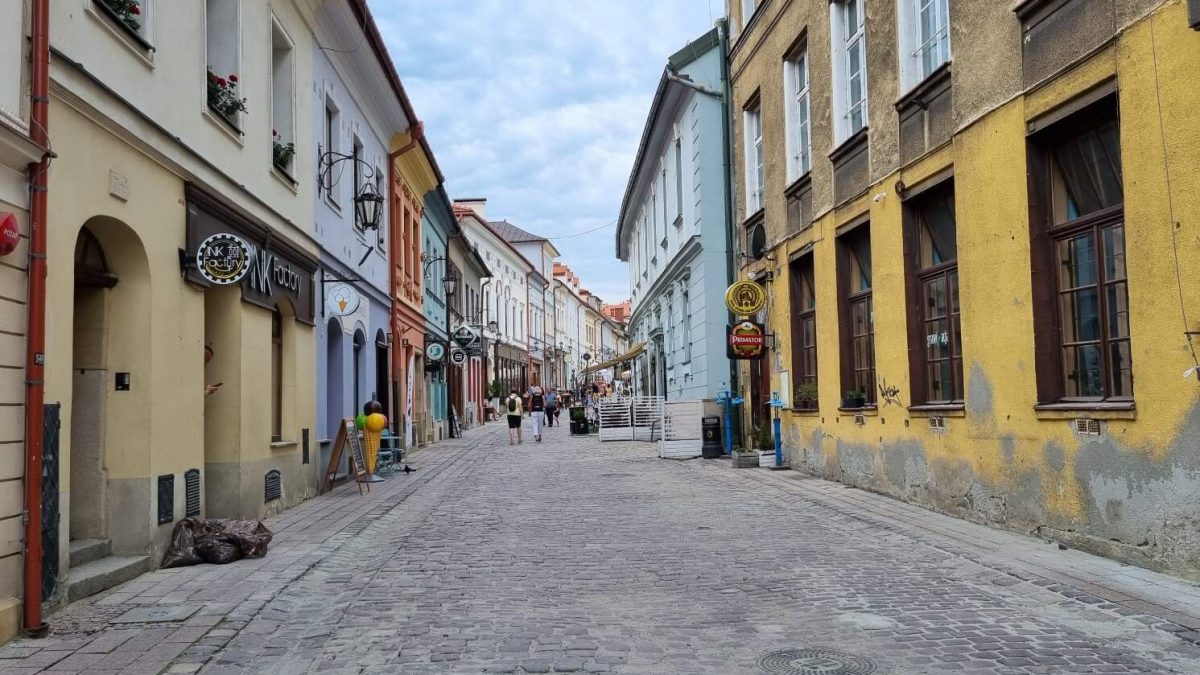
You can just feel the history all around you as soon as you step foot onto the Main Square. The shape of the square has not changed since it was measured out in the early 14th-century when Bielsko received its municipal rights.
In the 18th-century, wooden buildings dominated the landscape of the square. In 1746, there were only eight houses in the Old Town which were entirely made of brick. The modern appearance of the Market Square was most influenced by the reconstructions carried out after two huge fires struck the city in 1808 and 1836.
The Market Square functioned as a market until the mid-twentieth century. In the mid-1950s, it was transformed into a square.
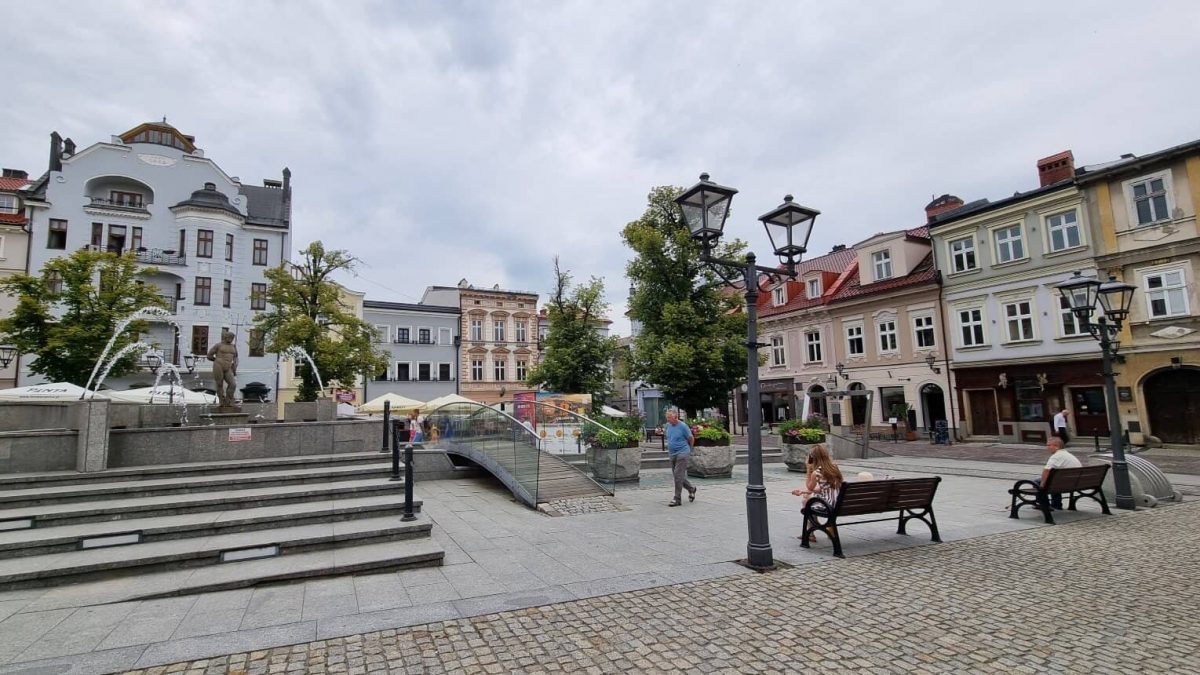
Excavation work on the west side of the Market Square has revealed the foundations of houses built from the Middle Ages up to the 19th-century. They were of wooden construction with stone cellars. Each of the 6.5m x 43m plots contained outbuildings in the centre, and gardens, cesspits and wells to the rear.
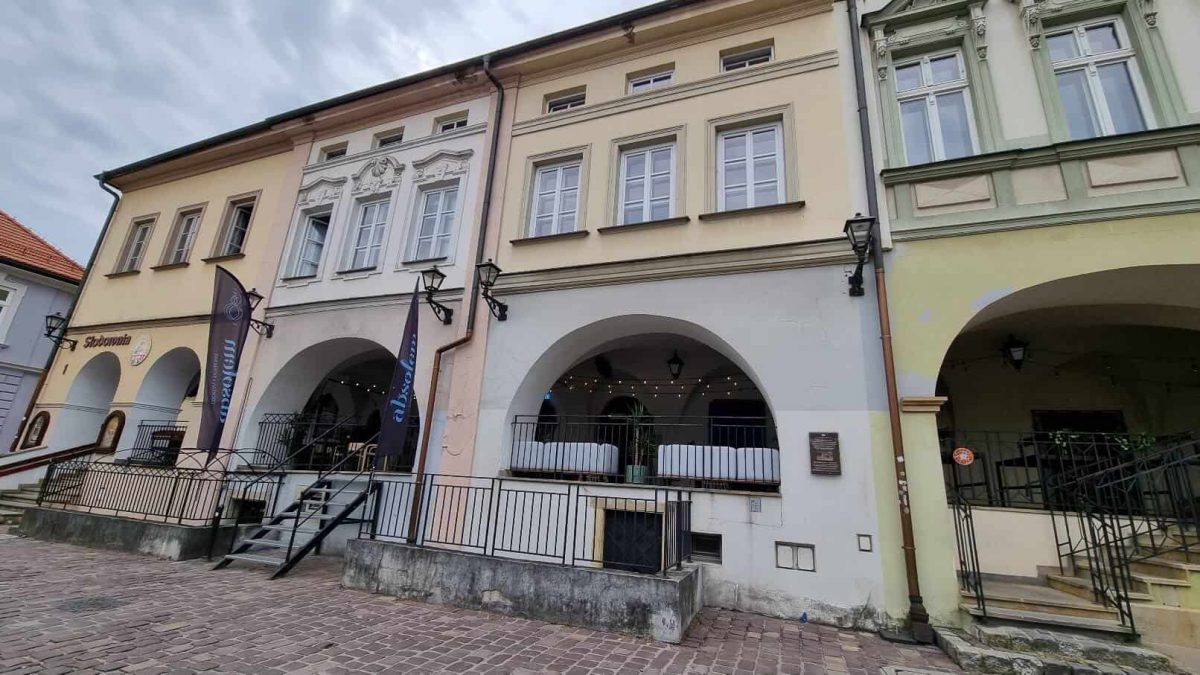
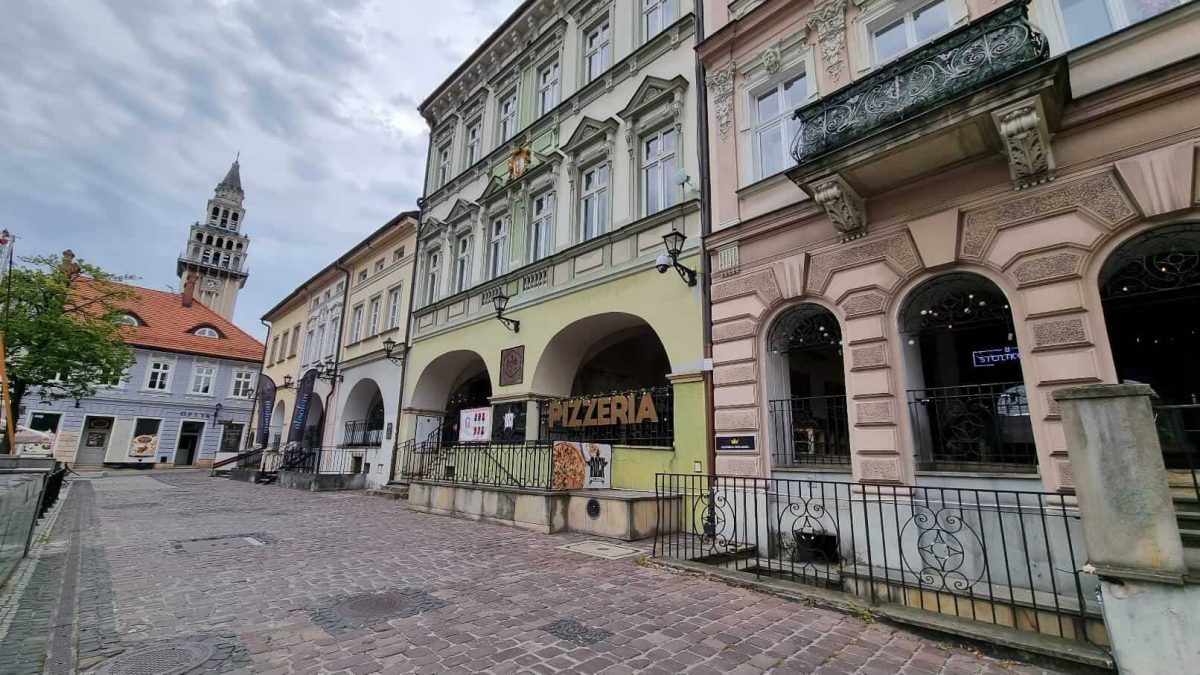
The centre of the Old Town Market Square
There are various sights worth checking out in the central part of the Old Town Market Square, including:
1. The Fountain with a Statue of the Roman God of the Sea Neptune
The Fountain with a Statue of the Roman God of the Sea Neptune is perhaps the standout sights on the Market Square. To the east, an artificial channel with a length of around 15 metres runs out of it. At the end of the canal, there is an illuminated model of the entire square.
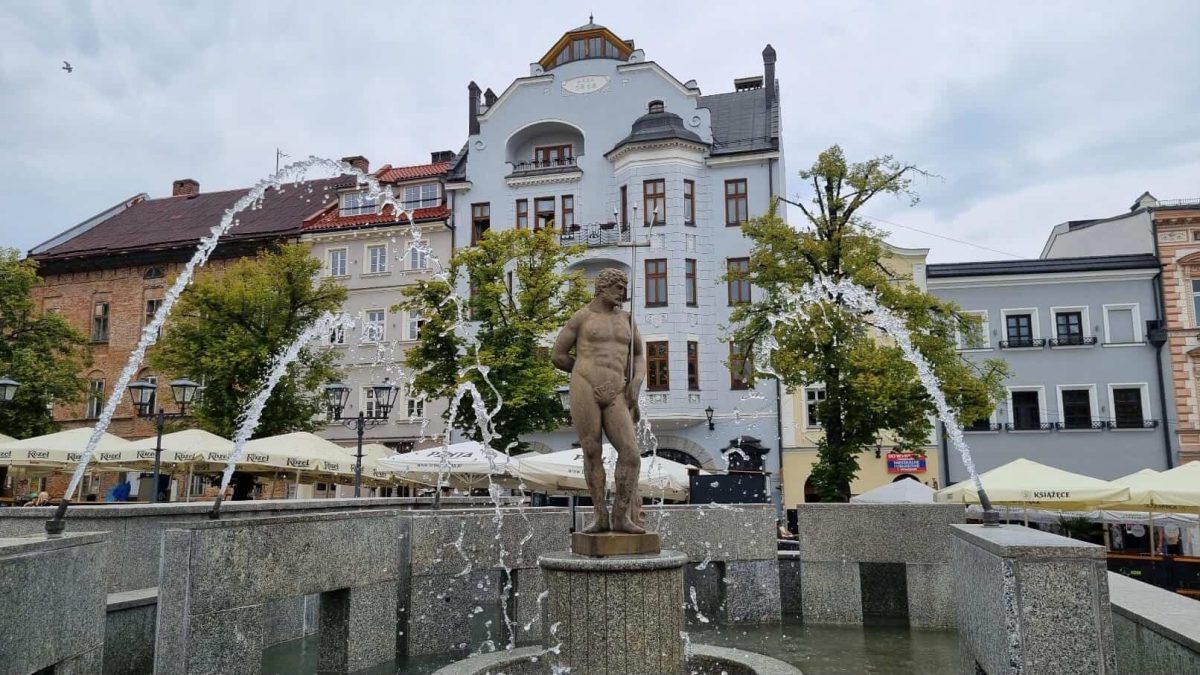
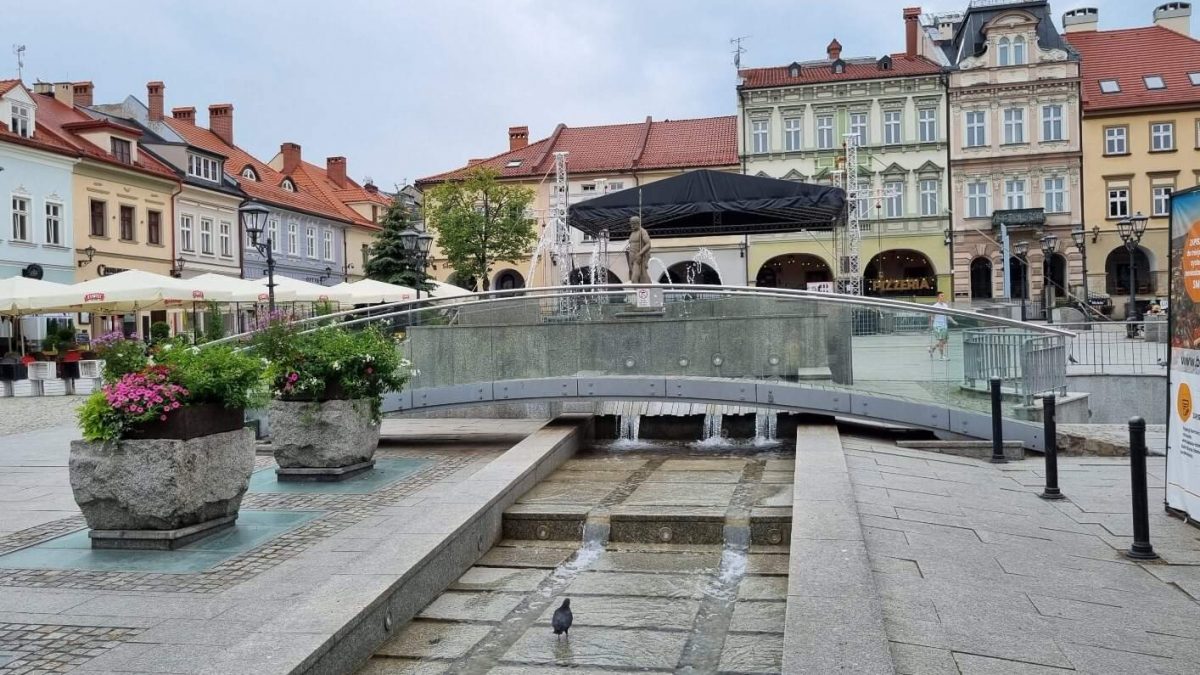
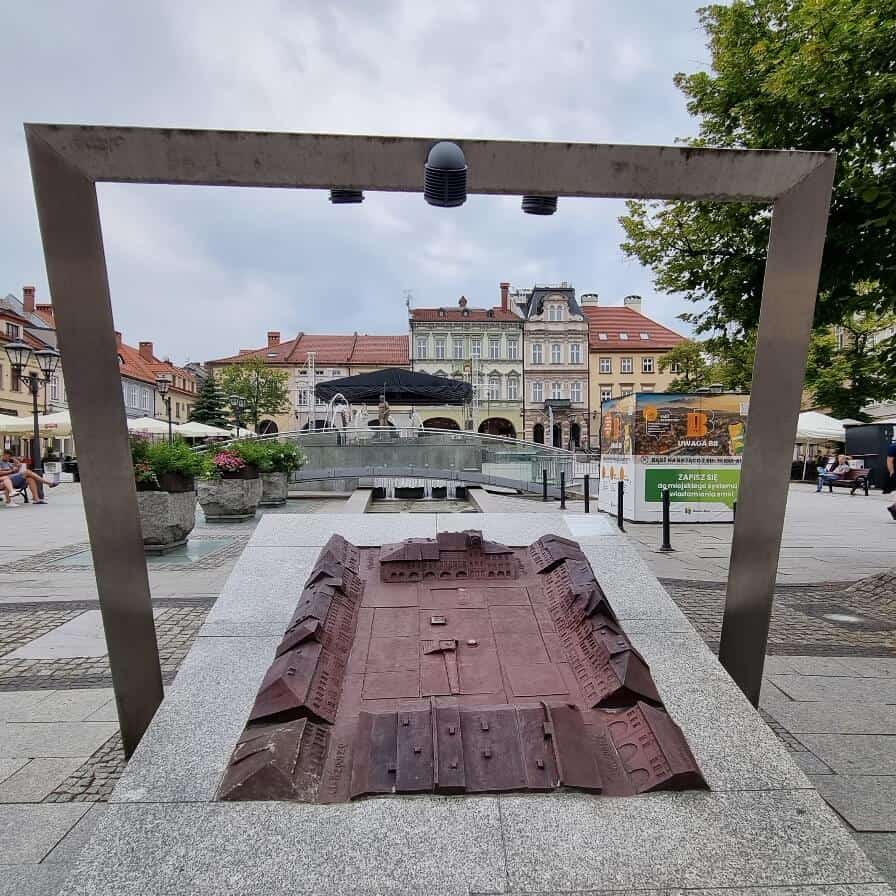
2. Statue of St.John of Nepomuk (pomnik św. Jana Nepomucena)
Until 1939, in the middle of the Market Square, there was a 19th-century statue of St. John of Nepomuk. St. John was an advocate of honest confessions, a guardian of family life and the patron of bridges and crossings. John also protected fields and crops against floods and drought.
In the 1930s, the statue was moved to the right porch of the church of St. Nicholas in Bielsko Biała. It remained there because the poor condition of the figure did not warrant its return to its former place.
In 2007, local sculptors Wiesław and Barbara Arminajtis recreated an entirely convincing copy of St. John right at the time when the Old Town was being revitalised. The figure of St. John of Nepomuk stands on a plinth with a decorative cornice and the text:
St. John of Nepomuk – a Czech priest drowned in the Vltava River on March 20, 1383 by order of King Władysław IV, to whom he did not want to reveal the secret of his wife’s confession. The figure of St. John of Nepomuk stood in this place until World War II.
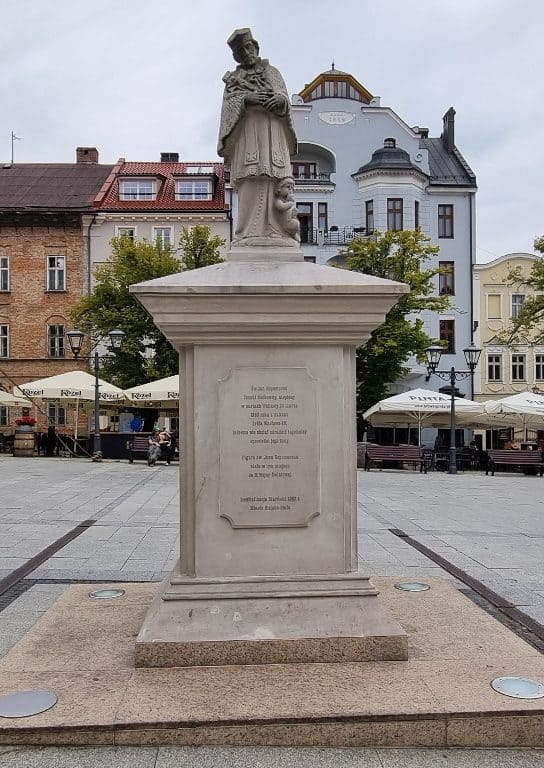
3. The Quarter-hour Clock
Built into the base of the Fountain with the Statue of Neptune is a most amazing Quarter-hour Clock.
This clock (Polish: Zegar kwadransowy) was built into the base of the fountain in the old market in Bielsko-Biala. The quarter-hour clock works in a 12-hour schedule with the hours marked in Roman numerals. The clock shows the time with an accuracy of 15 minutes (a quarter of an hour). Each hour is divided into four 15-minute segments.
When it is the last 15 minutes before a full hour, all segments in a single column are highlighted.
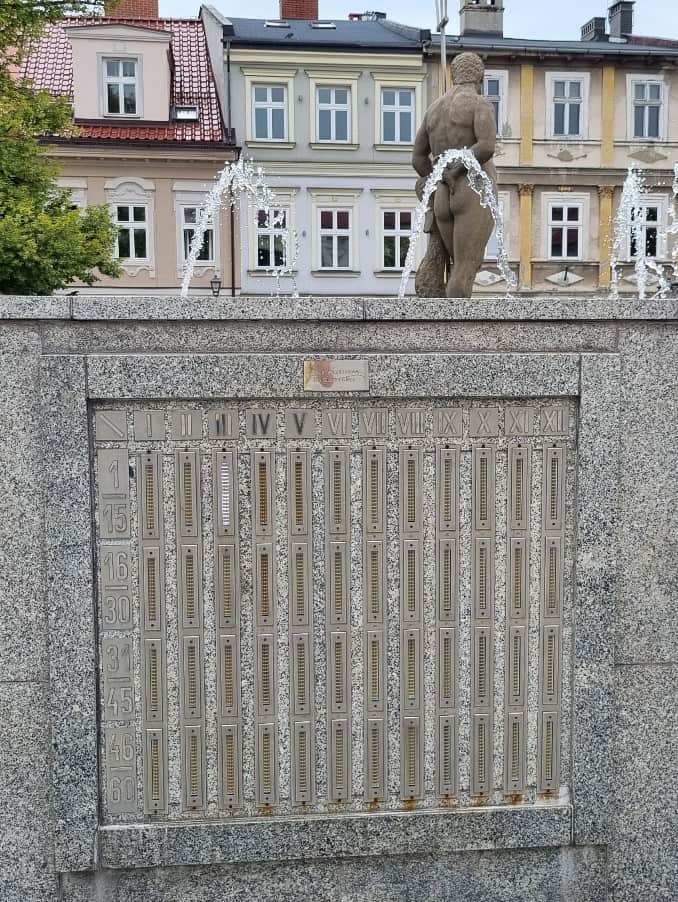
4. The Municipal Weigh House
In 1996, the remnants of the Municipal Weigh House were excavated. The building was erected in the 1600s and demolished at the beginning of the 1800s.
As the name Municipal Weigh House suggests, it was the place where all the goods brought for trade at the market were weighed. The fees for this service constituted a vital source of the town’s revenue.
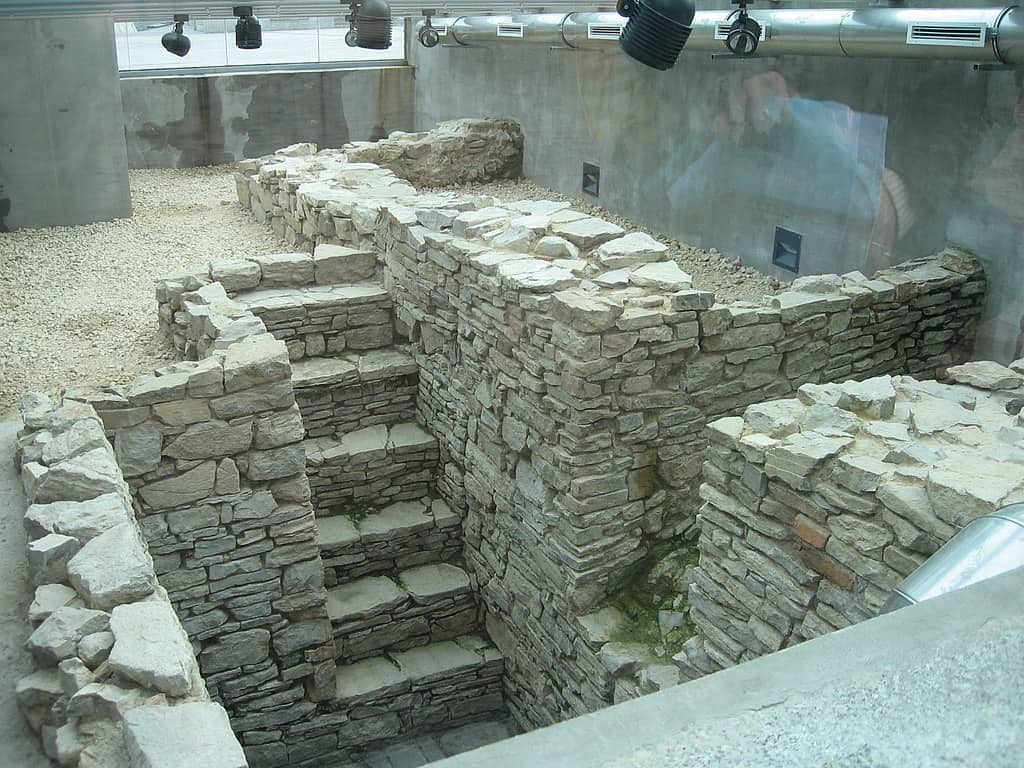
5. The Stone Well
The Stone Well was discovered in 1997 during archaeological excavations. It was most likely dug in the 17th century and filled back in during the 19th century.
The water well provided water for local residents as well as for visitors to the various fairs and markets which took place in the square.
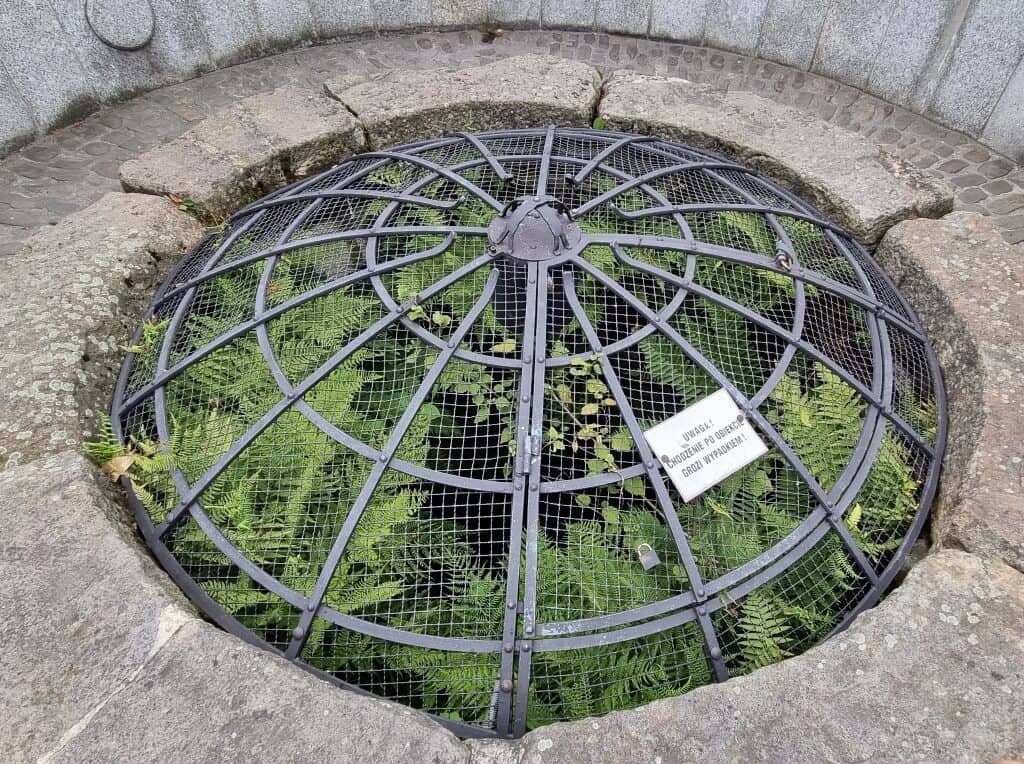
Reflecting on an unforgettable walking tour of Bielsko-Biała
It is my contention that Bielsko-Biała is a unique Polish city due to its captivating Old Town and the abundance of green spaces it has within its borders. Indeed, Bielsko-Biała is one of the greenest cities in Poland. What’s more, the Silesian Beskids mountain range creates a stunning backdrop to the city.
I have a feeling that citizens of Bielsko-Biała are spoiled for choice when winter arrives. For instance, Szczyrk mountain resort is just a 20-minute drive away to the south of Bielsko-Biała.
The walking tour of Bielsko-Biała I have proposed in this post took us around five hours, including breaks for food, drinks, a quick visit to Galeria Sfera shopping centre and taking pictures. Two full days in Bielsko-Biała would have enabled us to view other historical buildings, squares, statues and churches more closely. These sights include:
- The Statue of Martin Luther
- The Lutheran Church of Martin Luther
- The Lutheran Church of our Saviour
- The Roman Catholic Cathedral of St.Nicholas
- The tenement house “Under the Frogs”
- Wojska Polskiego Square
Finally, there is an aerial tramway – Kolej linowa Szyndzielnia – in the south of Bielsko-Biała. The length of the cable car journey to the top of Szyndzielnia mountain is 1.8km. There is an observation tower at the summit of the mountain.
Overall, I left Bielsko-Biała with only positive impressions of the city. I hope to return again in the coming years.
Further information
For further information about the history of Bielsko-Biała and recommended historic trails you can follow on foot around the city, check out this ‘Explore Bielsko-Biała’ guide that was compiled by the Town Hall of Bielsko-Biała.

